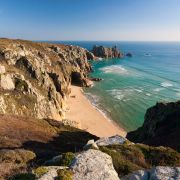One of three lighthouses functioning around the perilous waters of Land's End in the deep west of Cornwall, the base of Wolf Rock tower is a built into a steep, craggy rock about 8 miles out to sea. The impressive swells common to this area mean that the rock is rarely out of water, even in mild weather, thus the construction of a beacon of some description defied many an engineer before the present tower was built in the 1860s. The rock’s first beacon was a simple iron pole erected in the late 1700s, which the sea soon whipped away. In the first half of the 19th century, three similarly ill-fated beacons were attached to the rock, each taking years of effort to put in place (not helped by the very few days per year suited to any form of activity on the rock) and each removed much more quickly by the mighty sea.
Work on the hefty granite tower still in place today was commenced by Trinity House’s chief engineer at the time, Douglass, who was also the man behind the offshore lighthouses at nearby Longships and Eddystone, following a design by the previous chief engineer, James Walker. The stone was prepared in Penzance in a harbourside yard specifically used for this project, where the Trinity House Lighthouse Museum now stands. Special heavy-duty barges were employed to carry the stone to the steeple rock, and ingenious ways of getting it and the builders on and off the rock were devised, as no boat could easily put alongside the rock.
To withstand the serious buffeting it would receive, Wolf Rock lighthouse was given a very solid base, indeed the first nearly 40 feet of the tower are solid granite. From there on up, the walls are immensely thick, nearly 8 foot in the lower sections. As with the successful Eddystone lighthouse, the granite blocks are intricately dovetailed into one another, both horizontally and vertically, and the weight of the tower exceeds a massive 3,000 tons.
Electrically powered since 1955, Wolf Rock sported the world’s first lighthouse helicopter pad, which was built in 1972.






